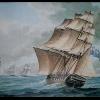HOLIDAY DONATION DRIVE - SUPPORT MSW - DO YOUR PART TO KEEP THIS GREAT FORUM GOING!
×
-
Posts
1,931 -
Joined
-
Last visited
Reputation Activity
-
 hamilton got a reaction from Bomber_County in Work area pictures only
hamilton got a reaction from Bomber_County in Work area pictures only
Hi Tim - nice looking space - I'm guessing you use that two-hander saw on the wall for particularly large modelling projects.
Here's my little corner of the world - though honestly it has not seen much use lately, sad to say - been too busy with work and home projects and other things for the last few months.....a couple of before shots of the dilapidated garage it used to be for comparison....the "after" photos were taken when it was more or less brand new (2021) - it is a bit messier now with more tools and more storage space....but it's a nice spot to be in on a sunny Saturday morning with a hot cup of coffee.
hamilton
-
 hamilton reacted to TerryPat in Bluenose by TerryPat - Model Shipways - 1:64
hamilton reacted to TerryPat in Bluenose by TerryPat - Model Shipways - 1:64
-Painted the bottom.
-Launch way in progress.
This is my first experience with water based acrylic paints and I have to say I'm a new fan! There are no nasty solvents involved and no nauseating smell.. It's like spitting daisies when spraying. I am very comfortable spraying in my basement. I know I'm not going to explode when the furnace kicks on. The little spray booth has a filter at the input of the blower unit to collect over spray. I use a respirator to be sure.
The acrylics spray well with my airbrush. They have great coverage with a nice matte finish. They brush well with very little brush strokes showing.
All for now.
-
 hamilton got a reaction from Bryan Woods in Work area pictures only
hamilton got a reaction from Bryan Woods in Work area pictures only
Hi Tim - nice looking space - I'm guessing you use that two-hander saw on the wall for particularly large modelling projects.
Here's my little corner of the world - though honestly it has not seen much use lately, sad to say - been too busy with work and home projects and other things for the last few months.....a couple of before shots of the dilapidated garage it used to be for comparison....the "after" photos were taken when it was more or less brand new (2021) - it is a bit messier now with more tools and more storage space....but it's a nice spot to be in on a sunny Saturday morning with a hot cup of coffee.
hamilton
-
 hamilton got a reaction from Tecko in Work area pictures only
hamilton got a reaction from Tecko in Work area pictures only
Hi Tim - nice looking space - I'm guessing you use that two-hander saw on the wall for particularly large modelling projects.
Here's my little corner of the world - though honestly it has not seen much use lately, sad to say - been too busy with work and home projects and other things for the last few months.....a couple of before shots of the dilapidated garage it used to be for comparison....the "after" photos were taken when it was more or less brand new (2021) - it is a bit messier now with more tools and more storage space....but it's a nice spot to be in on a sunny Saturday morning with a hot cup of coffee.
hamilton
-
 hamilton got a reaction from JohnOz in Cut and Paste - downloadable e-book featuring the work of Ab Hoving
hamilton got a reaction from JohnOz in Cut and Paste - downloadable e-book featuring the work of Ab Hoving
Beautiful work! A nice family project!
hamilton
-
 hamilton got a reaction from Taken Aback in HMS Sphinx 1775 by Ronald-V - Vanguard Models - 1:64
hamilton got a reaction from Taken Aback in HMS Sphinx 1775 by Ronald-V - Vanguard Models - 1:64
Have to agree with Russ and Javelin - the planking is very impressive - after 15 models I still cannot achieve these results....clearly something is eluding me that is more intuitive for you Ronald - patience, perhaps! In any event, this build is a real treat to follow
hamilton
-
 hamilton got a reaction from AJohnson in HMS Sphinx 1775 by Ronald-V - Vanguard Models - 1:64
hamilton got a reaction from AJohnson in HMS Sphinx 1775 by Ronald-V - Vanguard Models - 1:64
Have to agree with Russ and Javelin - the planking is very impressive - after 15 models I still cannot achieve these results....clearly something is eluding me that is more intuitive for you Ronald - patience, perhaps! In any event, this build is a real treat to follow
hamilton
-
 hamilton got a reaction from druxey in HMS Echo by Hamilton - Admiralty Models - 1:48 - cross-section
hamilton got a reaction from druxey in HMS Echo by Hamilton - Admiralty Models - 1:48 - cross-section
Thanks Druxey - I will make a couple of sanding jigs (concave and convex, using the deck beams as blanks to get the correct round-up. I have some 1/2" maple ply that I think I'll use for this purpose as it's mostly scrap anyway and will be firm enough to withstand some sustained kinetic action. Was thinking I'd sandwich a few pieces of this together to make a nice broad surface for the sanding of the beam arms. With the upper deck beams more or less completed and dry-fitting snugly, I think I can also proceed to a part of the build I'm looking forward to - making the bitt pins for the sheet and jeer bitts - the first bit of superstructural detail since I made the well...
In any event, at this point I probably won't be able to get back to Echo until mid-July, and then we're out of town again at the beginning of August....sheeesh - this summer is vanishing rapidly.....and it's not even summer!
hamilton
-
 hamilton got a reaction from Oboship in HMS Sphinx 1775 by Ronald-V - Vanguard Models - 1:64
hamilton got a reaction from Oboship in HMS Sphinx 1775 by Ronald-V - Vanguard Models - 1:64
Have to agree with Russ and Javelin - the planking is very impressive - after 15 models I still cannot achieve these results....clearly something is eluding me that is more intuitive for you Ronald - patience, perhaps! In any event, this build is a real treat to follow
hamilton
-
 hamilton reacted to Ronald-V in HMS Sphinx 1775 by Ronald-V - Vanguard Models - 1:64
hamilton reacted to Ronald-V in HMS Sphinx 1775 by Ronald-V - Vanguard Models - 1:64
Thank you so much Roel!
Thank you for your kind words Russ! You will learn so much from your first build, that will be a great springboard to new skills
Thank you so much Hamilton! 🙏 I must really give Chuck Passaro credits for his planking video's...that made good planking a lot more accessible....at least for me
Otherwise I think I would still be in the dark about how and what.
Thank you! Luckily these days I can also be happy with something less perfect sometimes
Thanks Jason! 👏
And thanks everyone else for the likes! Really appreciate it!
-
 hamilton got a reaction from Ronald-V in HMS Sphinx 1775 by Ronald-V - Vanguard Models - 1:64
hamilton got a reaction from Ronald-V in HMS Sphinx 1775 by Ronald-V - Vanguard Models - 1:64
Have to agree with Russ and Javelin - the planking is very impressive - after 15 models I still cannot achieve these results....clearly something is eluding me that is more intuitive for you Ronald - patience, perhaps! In any event, this build is a real treat to follow
hamilton
-
 hamilton got a reaction from SiriusVoyager in Work area pictures only
hamilton got a reaction from SiriusVoyager in Work area pictures only
Hi Tim - nice looking space - I'm guessing you use that two-hander saw on the wall for particularly large modelling projects.
Here's my little corner of the world - though honestly it has not seen much use lately, sad to say - been too busy with work and home projects and other things for the last few months.....a couple of before shots of the dilapidated garage it used to be for comparison....the "after" photos were taken when it was more or less brand new (2021) - it is a bit messier now with more tools and more storage space....but it's a nice spot to be in on a sunny Saturday morning with a hot cup of coffee.
hamilton
-
 hamilton got a reaction from GrandpaPhil in Work area pictures only
hamilton got a reaction from GrandpaPhil in Work area pictures only
Hi Tim - nice looking space - I'm guessing you use that two-hander saw on the wall for particularly large modelling projects.
Here's my little corner of the world - though honestly it has not seen much use lately, sad to say - been too busy with work and home projects and other things for the last few months.....a couple of before shots of the dilapidated garage it used to be for comparison....the "after" photos were taken when it was more or less brand new (2021) - it is a bit messier now with more tools and more storage space....but it's a nice spot to be in on a sunny Saturday morning with a hot cup of coffee.
hamilton
-
 hamilton got a reaction from rcweir in Work area pictures only
hamilton got a reaction from rcweir in Work area pictures only
Hi Tim - nice looking space - I'm guessing you use that two-hander saw on the wall for particularly large modelling projects.
Here's my little corner of the world - though honestly it has not seen much use lately, sad to say - been too busy with work and home projects and other things for the last few months.....a couple of before shots of the dilapidated garage it used to be for comparison....the "after" photos were taken when it was more or less brand new (2021) - it is a bit messier now with more tools and more storage space....but it's a nice spot to be in on a sunny Saturday morning with a hot cup of coffee.
hamilton
-
 hamilton got a reaction from Dave_E in Work area pictures only
hamilton got a reaction from Dave_E in Work area pictures only
@Nirvana - Yes that's my scratch Bluenose (the last model I completed) in an early stage of development - you'll also recognise Syren perched between the frames of another project I've been slowly working up in secret - a 1:48 scratch of HMS Scarborough based on the Anatomy of the Ship Blandford - which I'm building using a hybrid P.o.B. (from the gun deck downwards) P.o.F. (gundeck and above) approach - it's another version of the 1:100 scale Corel Greyhound I built as Blandford over a decade ago.....work at the bench is slow, but time still flies!!! Aspects of Einstein's relativity theory can be experienced in this way!
hamilton
-
 hamilton got a reaction from East Ender in Work area pictures only
hamilton got a reaction from East Ender in Work area pictures only
@Nirvana - Yes that's my scratch Bluenose (the last model I completed) in an early stage of development - you'll also recognise Syren perched between the frames of another project I've been slowly working up in secret - a 1:48 scratch of HMS Scarborough based on the Anatomy of the Ship Blandford - which I'm building using a hybrid P.o.B. (from the gun deck downwards) P.o.F. (gundeck and above) approach - it's another version of the 1:100 scale Corel Greyhound I built as Blandford over a decade ago.....work at the bench is slow, but time still flies!!! Aspects of Einstein's relativity theory can be experienced in this way!
hamilton
-
 hamilton got a reaction from robert952 in Work area pictures only
hamilton got a reaction from robert952 in Work area pictures only
@Nirvana - Yes that's my scratch Bluenose (the last model I completed) in an early stage of development - you'll also recognise Syren perched between the frames of another project I've been slowly working up in secret - a 1:48 scratch of HMS Scarborough based on the Anatomy of the Ship Blandford - which I'm building using a hybrid P.o.B. (from the gun deck downwards) P.o.F. (gundeck and above) approach - it's another version of the 1:100 scale Corel Greyhound I built as Blandford over a decade ago.....work at the bench is slow, but time still flies!!! Aspects of Einstein's relativity theory can be experienced in this way!
hamilton
-
 hamilton reacted to East Ender in Work area pictures only
hamilton reacted to East Ender in Work area pictures only
Beautiful transformation of your garage Hamilton! Nice work area. The big saw in the plastic modeling area is a 10 inch skill saw, no where else to put it. I like your tabletop, something I’m looking into as my wood work bench is a piece of &*#@. I went to move it slightly last week and it collapsed send my tools everywhere. I have clamps hold it together at the moment. One clamp visible under chair. Luckily Smuggler was not on it. Again nice job on your shop!!
-
 hamilton reacted to Nirvana in Work area pictures only
hamilton reacted to Nirvana in Work area pictures only
Hamilton, that is a great workshop - music area - man cave!
A little clean in my opinion ..... lol
Looks like there is a Bluenose on the table but I might be wrong.
-
 hamilton got a reaction from cotrecerf in Work area pictures only
hamilton got a reaction from cotrecerf in Work area pictures only
Hi Tim - nice looking space - I'm guessing you use that two-hander saw on the wall for particularly large modelling projects.
Here's my little corner of the world - though honestly it has not seen much use lately, sad to say - been too busy with work and home projects and other things for the last few months.....a couple of before shots of the dilapidated garage it used to be for comparison....the "after" photos were taken when it was more or less brand new (2021) - it is a bit messier now with more tools and more storage space....but it's a nice spot to be in on a sunny Saturday morning with a hot cup of coffee.
hamilton
-
 hamilton got a reaction from JohnB40 in Work area pictures only
hamilton got a reaction from JohnB40 in Work area pictures only
Hi Tim - nice looking space - I'm guessing you use that two-hander saw on the wall for particularly large modelling projects.
Here's my little corner of the world - though honestly it has not seen much use lately, sad to say - been too busy with work and home projects and other things for the last few months.....a couple of before shots of the dilapidated garage it used to be for comparison....the "after" photos were taken when it was more or less brand new (2021) - it is a bit messier now with more tools and more storage space....but it's a nice spot to be in on a sunny Saturday morning with a hot cup of coffee.
hamilton
-
 hamilton got a reaction from robert952 in Work area pictures only
hamilton got a reaction from robert952 in Work area pictures only
Hi Tim - nice looking space - I'm guessing you use that two-hander saw on the wall for particularly large modelling projects.
Here's my little corner of the world - though honestly it has not seen much use lately, sad to say - been too busy with work and home projects and other things for the last few months.....a couple of before shots of the dilapidated garage it used to be for comparison....the "after" photos were taken when it was more or less brand new (2021) - it is a bit messier now with more tools and more storage space....but it's a nice spot to be in on a sunny Saturday morning with a hot cup of coffee.
hamilton
-
 hamilton got a reaction from Dave_E in Work area pictures only
hamilton got a reaction from Dave_E in Work area pictures only
Hi Tim - nice looking space - I'm guessing you use that two-hander saw on the wall for particularly large modelling projects.
Here's my little corner of the world - though honestly it has not seen much use lately, sad to say - been too busy with work and home projects and other things for the last few months.....a couple of before shots of the dilapidated garage it used to be for comparison....the "after" photos were taken when it was more or less brand new (2021) - it is a bit messier now with more tools and more storage space....but it's a nice spot to be in on a sunny Saturday morning with a hot cup of coffee.
hamilton
-
 hamilton got a reaction from Jack12477 in Work area pictures only
hamilton got a reaction from Jack12477 in Work area pictures only
Hi Tim - nice looking space - I'm guessing you use that two-hander saw on the wall for particularly large modelling projects.
Here's my little corner of the world - though honestly it has not seen much use lately, sad to say - been too busy with work and home projects and other things for the last few months.....a couple of before shots of the dilapidated garage it used to be for comparison....the "after" photos were taken when it was more or less brand new (2021) - it is a bit messier now with more tools and more storage space....but it's a nice spot to be in on a sunny Saturday morning with a hot cup of coffee.
hamilton
-
 hamilton got a reaction from East Ender in Work area pictures only
hamilton got a reaction from East Ender in Work area pictures only
Hi Tim - nice looking space - I'm guessing you use that two-hander saw on the wall for particularly large modelling projects.
Here's my little corner of the world - though honestly it has not seen much use lately, sad to say - been too busy with work and home projects and other things for the last few months.....a couple of before shots of the dilapidated garage it used to be for comparison....the "after" photos were taken when it was more or less brand new (2021) - it is a bit messier now with more tools and more storage space....but it's a nice spot to be in on a sunny Saturday morning with a hot cup of coffee.
hamilton

















